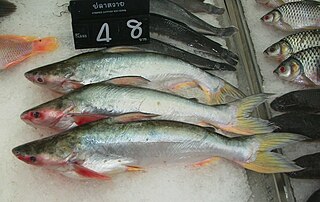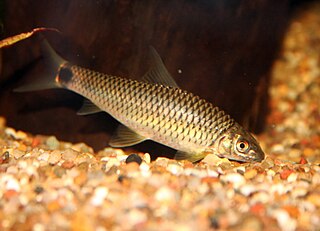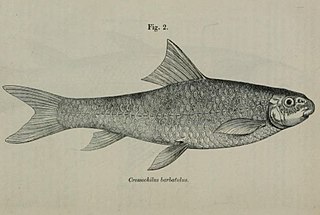
The Siamese algae-eater is a species of freshwater fish in the carp family, Cyprinidae. This bottom-dwelling tropical fish is found in mainland Southeast Asia, including the Chao Phraya and Mekong basins as well as the Malay Peninsula. Its natural habitats are streams and rivers as well as flooded forests during the rainy season. The Siamese algae-eater should not be confused with the flying fox or the false siamensis , lacking the distinctive black bands of the former.
Garra klatti, also known as the Isparta minnow or Anatolian golden barb, is a species of ray-finned fish in the genus Garra. It is found in the Lake Işıklı basin in the Büyük Menderes drainage in Turkey. There is some confusion regarding the identity of this fish. This poorly known species is closely related to Garra kemali, and likely should be placed in that genus.

The white-throated bulbul is a species of songbird in the bulbul family, Pycnonotidae. It is found in south-eastern Asia from the eastern Himalayas to Myanmar and western Thailand. Its natural habitat is subtropical or tropical moist lowland forests.

Pangasius pangasius, the Pangas catfish, is a species of shark catfish native to fresh and brackish waters of Bangladesh, India, Myanmar, and Pakistan. It has also been introduced to Cambodia and Vietnam. This species grows to a standard length of 3 metres (9.8 ft). This species of fish is eaten by the people of South Asia, the other being P. silasi from the Krishna River.

The bronze featherback is a ray-finned fish in the family Notopteridae found in South and Southeast Asia. Although primarily found in fresh water, it has been known to enter brackish water. At present, it is the only member of the genus Notopterus, but as currently defined, it is likely a species complex.

Puntius burmanicus is a species of cyprinid fish endemic to Myanmar and only known from Mergui. It grows to 10 cm (3.9 in) TL.

Crossocheilus, also known as the fringe barbs, flying foxes, or "algae eaters", is a genus of fish in the family Cyprinidae. It is distributed in China, India, Indonesia, Malaysia and Thailand in Asia. These fish occur in several types of habitat, often fast-flowing rivers with rocky bottoms.

Tariqilabeo periyarensis is a species of fish in the family Cyprinidae. This species is only found in Periyar River in Kerala, India.

Caragobius is a genus of gobies native to Asia and the western Pacific Ocean.

The Himalayan buzzard is a medium to large bird of prey that is sometimes considered a subspecies of the widespread common buzzard. It is native to the Himalayas in Nepal, India and adjacent mountains of southern China.
Glyptothorax burmanicus is a species of fish in the family Sisoridae.

Crossocheilus atrilimes is a species of freshwater fish in the family Cyprinidae. It is found in Laos, in Thailand, and in Cambodia.

Crossocheilus reticulatus is a freshwater fish in the family Cyprinidae from Southeast Asia. It grows to 17 cm (6.7 in) standard length.
Crossocheilus obscurus is a species cyprinid fish. It occurs on Sumatra (Indonesia) and in Peninsular Malaysia. It lives in fast flowing steams with rocky substrate.
Crossocheilus gnathopogon is a species of ray-finned fish in the genus Crossocheilus. It is native to Sumatra.
Crossocheilus nigriloba is a species of ray-finned fish in the genus Crossocheilus. It is native to eastern Borneo.
The Antakya minnow or Orontes golden barb, is a species of ray-finned fish in the genus Garra. There is some confusion regarding the identity of this fish. Formerly thought to be extinct, when occupying the Orontes watershed in Turkey, however a synonym, Hemigrammocapoeta caudomaculata is identified as least concern by the IUCN, and is found in the Asi drainage in Turkey and Syria and Nahr al-Kabir river on the border between Syria and Lebanon, and called the Asi golden barb. They are now considered to be the same species.

Tariqilabeo diplochilus is a species of ray-finned fish in the genus Tariqilabeo. It is found in the Indus drainage in Pakistan, Afghanistan and India, extending into the Iranian Sistān, and coastal drainages in Pakistan.
Cochlefelis burmanicus is a species of catfish in the family Ariidae. It was described by Francis Day in 1870, originally under the genus Arius. It is known from brackish and freshwaters in Myanmar and Thailand. It reaches a length of 40 cm (16 in).
Scaphiodonichthys burmanicus is a species of cyprinid fish of the genus Scaphiodonichthys. It inhabits inland wetlands in Myanmar where it is locally used for food. It has been assessed as "least concern" on the IUCN Red List. It has a maximum length of 22 cm (8.7 in). It is considered harmless to humans.












